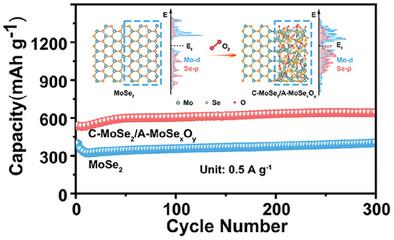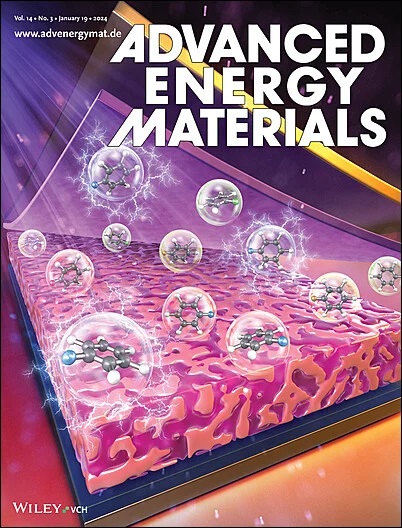微晶-非晶异质界面网络对钠离子电池快速充电的电荷自调节效应
IF 24.4
1区 材料科学
Q1 CHEMISTRY, PHYSICAL
引用次数: 0
摘要
钠离子电池(SIB)因其丰富的资源可用性而逐渐成为传统电池的可行替代品。然而,电子/离子动力学迟缓阻碍了钠离子电池技术的进一步发展。在此,通过对晶体 MoSe2 进行原位低温氧化,开发出了一种新型微晶-MoSe2/非晶-MoSexOy(C-MoSe2/A-MoSexOy)。微晶 MoSe2 起到了稳固框架的作用,而无定形 MoSexOy 相则填充了间隙空间。这种阳极材料的特点是具有优化的微晶-非晶异质界面。由此产生的电荷自调节效应可用于调节有源电子状态,从而确保高速、稳定的钠存储性能。这种异质表面具有超高比容量(0.5 A g-1 时为 641.0 mAh g-1),并能在 100 A g-1 时保持出色的速率性能(324.2 mAh g-1)。详细的理论和实验研究表明,性能增强的原因是 C-MoSe2/A-MoSexOy 中微晶-非晶异质界面的电荷自调节效应产生了活跃的电子态,其特点是活跃的 Mo─Se 键调节了界面电荷的重新分配,促进了微晶和非晶相之间活跃界面的电子转移。研究结果表明,异质界面网络产生的电荷自我调节效应从本质上加速了电子/离子传输,为快速充电电池提供了一种前景广阔的电极设计策略。本文章由计算机程序翻译,如有差异,请以英文原文为准。

The Charge Self-Regulation Effect Induced by Microcrystalline-Amorphous Heterointerface Network Toward Fast Charging Sodium Ion Batteries
Sodium-ion batteries (SIBs), recognized for their abundant resource availability, are emerging as a viable alternative to conventional batteries. Nevertheless, sluggish electrons/ions kinetics impedes further advancement in SIBs technology. Herein, a novel microcrystalline-MoSe2/amorphous-MoSexOy (C-MoSe2/A-MoSexOy) is developed through in situ low-temperature oxidation of crystalline MoSe2. The microcrystalline MoSe2 acts as a robust framework, while the amorphous MoSexOy phase fills the interstitial spaces. This anode material is characterized by an optimized microcrystalline-amorphous heterointerface. The resultant charge self-regulation effect can be exploited to modulate active electron states, thereby ensuring high-speed and stable sodium storage performance. The heterointerface demonstrates an ultrahigh specific capacity (641.0 mAh g−1 at 0.5 A g−1) and maintains splendid rate performances up to 100 A g−1 (324.2 mAh g−1). Detailed theoretical and experimental researches indicate that the enhanced performance results from the production of active electronic states, which are initiated by the charge self-regulation effect at the microcrystalline-amorphous heterointerface in C-MoSe2/A-MoSexOy, featuring active Mo─Se bonds, which regulates the interfacial charge redistribution and facilitate electron transfer across the active interface between the microcrystalline and amorphous phases. The findings suggest that the charge self-regulation effect, prompted by the heterointerface network, inherently accelerates electron/ion transport, offering a promising electrode design strategy for fast-charging batteries.
求助全文
通过发布文献求助,成功后即可免费获取论文全文。
去求助
来源期刊

Advanced Energy Materials
CHEMISTRY, PHYSICAL-ENERGY & FUELS
CiteScore
41.90
自引率
4.00%
发文量
889
审稿时长
1.4 months
期刊介绍:
Established in 2011, Advanced Energy Materials is an international, interdisciplinary, English-language journal that focuses on materials used in energy harvesting, conversion, and storage. It is regarded as a top-quality journal alongside Advanced Materials, Advanced Functional Materials, and Small.
With a 2022 Impact Factor of 27.8, Advanced Energy Materials is considered a prime source for the best energy-related research. The journal covers a wide range of topics in energy-related research, including organic and inorganic photovoltaics, batteries and supercapacitors, fuel cells, hydrogen generation and storage, thermoelectrics, water splitting and photocatalysis, solar fuels and thermosolar power, magnetocalorics, and piezoelectronics.
The readership of Advanced Energy Materials includes materials scientists, chemists, physicists, and engineers in both academia and industry. The journal is indexed in various databases and collections, such as Advanced Technologies & Aerospace Database, FIZ Karlsruhe, INSPEC (IET), Science Citation Index Expanded, Technology Collection, and Web of Science, among others.
 求助内容:
求助内容: 应助结果提醒方式:
应助结果提醒方式:


